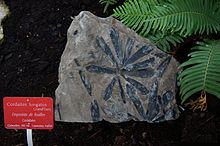Cordaites
Appearance
| Cordaites Temporal range:
| |
|---|---|

| |
| Cordaites lungatus | |
| Scientific classification | |
| Kingdom: | |
| Division: | |
| Class: | |
| Order: | |
| Family: | |
| Genus: | Cordaites
|
| Species | |
| |
Cordaites is an important genus of extinct gymnosperms which grew on wet ground similar to the Everglades in Florida. Brackish water mussels and crustacea are found frequently between the roots of these trees. The fossils are found in rock sections from the Upper Carboniferous (323 to 299 million years ago) of the Dutch - Belgian - German coal area. A number of many noteworthy types from this line are:
- Cordaites principalis
- Cordaites ludlowi (named after Ludlow, a coal area in England)
- Cordaites hislopii. Found in Paleorrota geopark in Brazil.[1]
In contrast to many other plants, Cordaites seeds are not rare, because they are rather large (up to 10 mm); those seeds are named Cordaicarpus.
References
- ^ "Herbivoria Em Floras Gonduânicas Do Neopaleózoico Do Rio Grande Do Sul: Análise Quantitativa" (PDF), Revista Brasileira de Paleontologia, 7 (2): 93–102, 2004
{{citation}}: Unknown parameter|authors=ignored (help)
